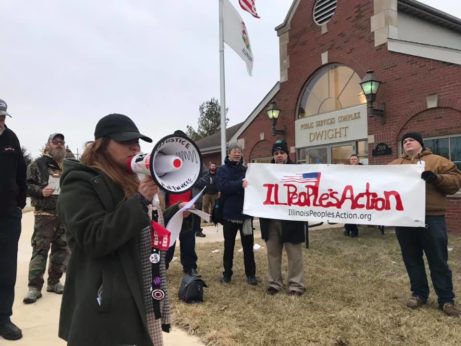
DWIGHT, Ill.—On Feb. 8, news broke that the town of Dwight is being considered for a $20 million private detention facility for undocumented immigrants.
The small central Illinois town of about 4,000 lies about an hour and a half south of Chicago on I-55. The Immigration and Customs Enforcement (ICE) facility would be built and operated by Immigration Centers of America (ICA).
Dwight’s planning commission scheduled a Feb. 19 vote on the proposal. On Feb. 9, local activists in Bloomington-Normal, the twin cities an hour south of Dwight, began to organize on social media using the #NoICEDwight hashtag. Started by Sonny Garcia, an organizer with Illinois People’s Action and Bloomington-Normal Democratic Socialists of America, the movement quickly gained momentum.
No ICE Dwight organized a rally in Bloomington-Normal on Feb. 12 and then packed the Feb. 19 planning commission hearing.
There has been widespread coverage of ICE facilities in recent months—from family separation in the heartland of the U.S and the ‘Zero Tolerance’ policy at the border to physical and sexual abuse—and death. ICE has also destroyed detainment and immigrant records, including those of abuse, assault, and death in custody.
The United States has a long history of immigrant detention, including at Ellis and Angel Islands, Guantanamo Bay, and local jail and prison centers. However, in response to the Oklahoma City terrorist bombing in 1996 and the ever-pervasive war on drugs, President Bill Clinton signed into law the Anti-terrorism and Effective Death Penalty Act of 1996 and the Illegal Immigration Reform and Immigrant Responsibility Act of 1996. The passage of the latter produced a spike in the detention of immigrants in subsequent years, a trend which continues to this day.
These two acts alone are not to blame for the increased detention of immigrants, of course. Immigration as a source of labor and increasing pleas for asylum are rooted in globalization and imperialist intervention by the United States, particularly in Latin America. Before these acts became law, the U.S invaded Panama in 1989, gave “aid” in the form of weapons to Colombia to fight cartels and left-wing groups, trained the Contras against the Nicaraguan Sandinista government, and supported bloody regimes in El Salvador and Guatemala.
War, destabilization, rampant crime and violence, and neoliberal trade agreements drove thousands to flee their homes to the relative safety of the U.S. The flow of migrants has not stopped, sometimes taking the form of caravans to the U.S.-Mexico border.

The private prison industrial complex is not new. It seeks greater profits by cutting costs and increasing the number of inmates. To do so, they avoid recidivism reduction policies, hire under- or untrained staff, build with the cheapest possible labor and materials, lobby for harsher sentencing, and expand their “market” to other types of detention facilities. This last method brings us back to the proposed ICE detention facility in Dwight.
Over 100 activists from 10 cities packed the Feb. 19 planning commission meeting. Part of the group rallied outside as a small delegation participated in the discussion. During the open forum, concerns were raised over employee pay, project labor agreements, longevity, and contractual agreements between ICA and ICE. Despite opposition, the proposal passed the planning commission 3-2 and moved to the village council for a Feb. 25 vote. However, due to questions raised and opposition from No ICE Dwight, the council postponed the vote to March 11.
At the February village council meeting, opponents of the ICE facility addressed the negative impacts it could produce for not only Dwight but central Illinois as a whole. ICA has a track record of employing non-unionized workers with high turnover, employee trauma, low wages, and no pensions.
For Dwight, the issue is a hard one to decide. Morality aside, the village and region are economically depressed, with few opportunities for residents. A state women’s prison in the area closed in 2013 with the loss of several hundred jobs. Many believe a new ICE facility would breathe needed economic development into the town, even with the weak employment record of ICA.
It should come to no one’s surprise that ICA is looking to exploit the economic stagnation of a small town after similar facilities were rejected in Indiana and Michigan. Leaving small and rural towns behind in an era of increased automation and globalization is one of the many failures of capitalism. The state of Illinois has done little for its small towns, often letting them fend for themselves or bleed out entirely.
No ICE Dwight is planning a rally for the March 11 vote. Illinois People’s Action is sponsoring a bus to help shuttle residents from Bloomington-Normal to Dwight and seeking donations for more buses. You can also follow No ICE Dwight on Facebook for the latest developments.

MOST POPULAR TODAY

High Court essentially bans demonstrations, freedom of assembly in Deep South

Resource wars rage in eastern Congo, but U.S. capitalism only sees investment opportunity

U.S. imperialism’s ‘ironclad’ support for Israel increases fascist danger at home

UN warns that Israel is still blocking humanitarian aid to Gaza







Comments